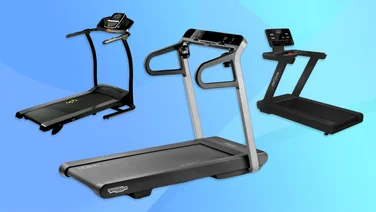To help us provide you with free impartial advice, we may earn a commission if you buy through links on our site. Learn more











- Near silent cycling experience
- Plenty of riding positions
- Accurate and realistic
- Some drop-out issues
- There are cheaper options
- A little lag in ERG modes
Keen cyclists will have noticed that the recent explosion in popularity of indoor training has led to all manner of innovation. Where turbo trainers were once rudimentary rollers onto which you plonked a standard road bike, they’ve now become smart controllers that can accurately and realistically simulate cycling outdoors.
The Wattbike Atom, which first hit the scene in 2017, was arguably the first of this new breed of “all-in-one” indoor cycling trainers, with the likes of Wahoo and Tacx rapidly following in its footsteps.
Now into its second generation, the Wattbike Atom has a faster and more powerful resistance system, which does away with the old motors that used to physically move magnets up and down on a flywheel to alter resistance, and moves to a system that directly adapts the current sent to the magnet.
It’s a very responsive system and makes gear changes crisper and faster, while anyone using a virtual training platform such as Zwift will notice the changes in gradients immediately, with very little lag. Maximum resistance is now up there with the best on the market, too, offering a staggering 2,500 watts at 130rpm, while the addition of a cadence sensor to the flywheel and a new crank angle sensor allow for deeper analysis of performance metrics.
It’s a cycling geek’s paradise, but also perfectly approachable for those who just want to get fit and have fun indoors.
Wattbike Atom review: What do you get for the money?
Let’s not beat around the bush here: at £1,999 the Wattbike Atom is a sizable investment for any indoor cycling fan. It costs twice as much as some smart turbo trainers, although you will have to provide your own bike to operate those.
Despite the price, though, it’s actually pretty good value. It’s beautifully made, built to withstand the rigours of professional athlete training and it compares well on features with its main rivals – the Wahoo Kickr Smart Bike (£3,300) and the Tacx Neo (£2,300).
It looks great, too. In fact, it’s striking just how realistic Wattbike has managed to make the indoor cycling experience without the entire setup looking like some strange floating road bike, as is the case with some rivals.











And it does this while providing plenty of practicality and adjustability. The saddle, which is a neat replica of an aerodynamic road bike unit, can be raised via a simple quick release, and can also slide fore and aft. The handlebars can move both forwards and backwards, as well as up and down.
Wattbike provides some very basic flat pedals with nylon strapping but most keen cyclists will want to swap these out for more advanced clipless units, such as Shimano’s SPD-L range or Wahoo’s Speedplay units. These allow riders to properly clip into the pedals in order to get the most out of each power phase of every leg stroke and, in turn, get more accurate data metrics during and after a workout.
There’s an adjustable and spring-loaded mount at the top of the time trial handlebars, which slides up and down to accommodate different-sized devices, to seat a smartphone or a tablet (you can’t fit both). You’ll need to take advantage of this because the Wattbike has no display of its own.
One thing to be aware of, though: as with most commercial standard exercise machines, it’s not particularly easy to move about. Small wheels at the front of the frame allow for some movement but it weighs a hefty 45kg, so it isn’t something you’ll want to be picking up and hauling up and down the stairs all that often. Wattbike delivers the Atom via Panther Logistics, so it’s possible to select a delivery date and time that’s convenient. Just make sure they are aware of any stairs or difficulty in delivering such a large and heavy package.
The rest of the setup is pretty much plug and play, with very clear instructions on how to tether a smartphone, tablet and other devices.
Apart from that, the money goes towards ANT+, Bluetooth and FTMS (FiTness Machine Service) connectivity (to help with device pairing), and the fantastically powerful magnetic flywheel that creates the resistance.
READ NEXT: Our full roundup of the best turbo trainers
Wattbike Atom review: What’s new in this next generation?
As previously mentioned, this second-generation Wattbike has gone back to the drawing board with its resistance system. Where the previous model relied on analogue motors to move magnets and create step changes in resistance, this new Atom alters the current directly to the electromagnet itself.











The result is a much faster response to gear changes and changes in elevation when using an ERG mode on a virtual training platform such as Zwift. Essentially, an ERG mode sends a signal to the bike to tell it you’re approaching a virtual climb and the resistance at the cranks then responds accordingly. The steeper the climb, the harder you’ll find it to rotate the cranks.
That’s the main advance, but there are other additions. Wattbike has added more sensors, so riders can go into crazy levels of detail when it comes to working out left/right power splits, cadence, power output and more. A new crank angle sensor, for instance, reads 48 times per revolution, compared with the two per revolution of the Atom launched in 2017, enabling the bike to make faster decisions, adjusting the resistance without having to wait for either a half or full turn of the pedals.
Wattbike Atom review: What’s it like to use?
Generally speaking, using the Wattbike Atom is pretty straightforward. It’s designed to be paired with the free companion mobile app, so you’ll need to download that and pair it before you get started but, once done, the bike is able to simulate short, sharp inclines, lengthy climbs and steep declines, with the resistance automatically increasing or decreasing. From here, the rider can then cycle through the gears, as with a real bike, to help find a ratio to tackle said climb.
Wattbike provides a plethora of workouts that aim to help you improve everything from racing endurance to sprinting prowess, while long-term training plans can be formulated and carried out, covering things such as training for your first 100-mile ride to preparing for a seven-day event.











It’s clever stuff and it’s pretty accurate as well. Wattbike claims +/-1 per cent accuracy with its internal power meters and I found it compared favourably to a set of Garmin Rally power pedals I attached to the bike.
However, despite Wattbike’s own app delivering reams of live (and sometimes overwhelming) data, I found the most fun was had when using a virtual training platform such as Zwift. Here, the Atom’s massive amounts of resistance and fast reaction times make it not only good for training but also live races.
I’ve used other trainers that aim to better simulate road surfaces and the sort of side-to-side swaying found when sprinting, but I must say I didn’t pine for it with the Atom. It’s perfectly good as it is and feels so well built, it gives the impression it can withstand an exceptional amount of force through the cranks.
Wattbike Atom review: What didn’t we like about it?
The overall styling of the second generation Atom is smart, but I found the tall top tube a little tricky to throw a leg over. This isn’t so bad when first getting on the bike but when your legs are all wobbly following a strenuous workout, it does get bothersome.
Similarly, the Time Trial bars, which can be removed but are easily attached to the traditional handlebars and provide a place to slot a tablet, make the overall seating position feel quite stretched, which isn’t great for the lower back over long sessions.
What’s more, Wattbike only provides a holder for either a phone or a tablet, not both. That means if you use a secondary companion app on your smartphone, such as Zwift’s Companion App, which allows you to chat to other users and explore the maps or MyZone’s heart-rate tracking, you’ll have to find a way of mounting your phone to the bars. Either that or free up the tablet slot by using a wall-mounted monitor, TV or screen as your main virtual training tool.











Elsewhere, I also experienced random resistance drop-outs during my early hours testing the bike. This was only when using Zwift and when pushing over 300W through the cranks, but the issue saw the resistance mysteriously bleed away to nothing and I had to restart my session. After chatting to customer services, this was resolved when I updated both software and firmware on the machine, but it was not something I expected to have to sort out.
The only other problem I experienced was when using ERG training modes in Zwift. ERG training modes generally ask you to hold a set amount of wattage for a set period of time, rather than simulating a climb or a descent. During short bursts of effort, say holding 500W for 30 seconds, it took a few seconds for the Wattbike Atom to settle on the right amount of resistance to match the desired wattage output. Sometimes it felt too tough, forcing me to pedal far harder than the set wattage, while other times there wasn’t enough resistance, so I was left spinning like crazy.
This isn’t isolated to the Wattbike alone – I’ve tested other smart trainers that have suffered with similar issues – and it’s a fairly small part of the overall Zwift experience, but it does get a bit frustrating when you’re regularly missing your targets because the bike can’t decide on the right resistance for the wattage output.
READ NEXT: Power up with our selection of the best electric bikes
Wattbike Atom review: should you buy one?
Although seen as hideously expensive and a tad overkill when it first arrived in 2017, the Wattbike Atom now has a handful of direct rivals that either cost more or come in at a similar price. I’d say this new version is up there with the best of them. In fact, it’s my personal favourite indoor cycling trainer: it looks great in the house and handles wonderfully well, offering a solid cycling experience for a broad array of users and applications. It isn’t just for ardent road cyclists.
But then others might appreciate the real road simulation offered by a brand such as Taxc, or prefer Wahoo’s latest Kickr Bike, which now has Wi-Fi connectivity for the best connection to external devices and the most reliable link when racing or competing online.
It’s also possible to achieve a similar experience with a smart “wheel on” trainer from the likes of Tacx and Wahoo but, with those, you’ll have to provide a bike. When it comes to dedicated setups, they don’t get much better than the Atom.






